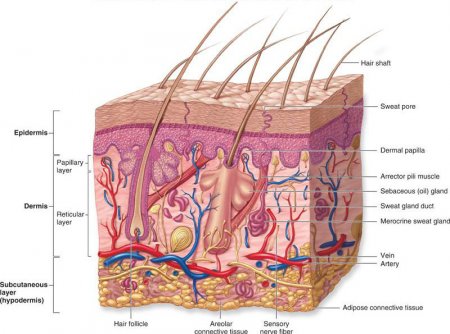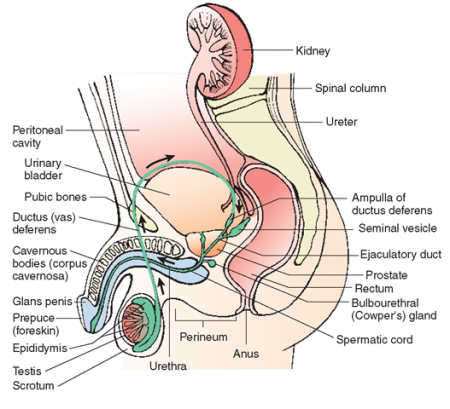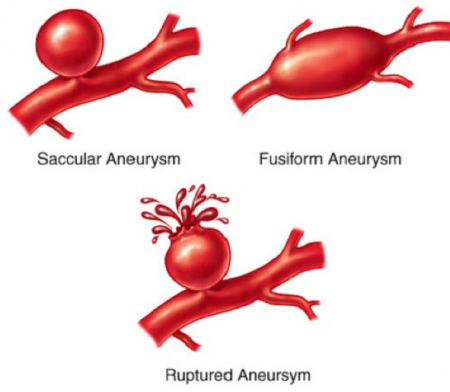The integumentary system of the head and neck
- Category: Integumentary System
- Views: 8739
The integumentary system of the head and neck includes the skin and hair of the face, head and neck. The skin of the face is the part of the body which is most often exposed to sunlight, the elements, and environmental pollutants; thus, it is more prone to acne and to becoming dry or otherwise showing accumulated damage from these influences than the skin on the rest of the body.
The epididymis
- Category: The male reproductive system
- Views: 77594

The epididymis (plural, epididymides) is a tightly coiled mass of thin tubes that carries sperm from the testes to the ductus deferens in the male reproductive system. Sperm matures as it passes through the epididymis so that it is ready to fertilize ova by the time it enters the ductus deferens.
The epididymis is a crescent-shaped coil of thin tubules located inside the scrotum and posterior to the testis. The entire mass of the epididymis is actually a single, 20-foot-long (six-meter) tubule that has been coiled upon itself so tightly that the entire mass of the epididymis is only around 1.5 inches (4 cm) long. Starting at the efferent tubules of the testis, the tubule of the epididymis winds over the top of the testis and then down the posterior side. Then, near the bottom of the testis, it turns 180 degrees and continues superiorly before joining the ductus deferens.
The ductus deferens
- Category: The male reproductive system
- Views: 89017
The ductus deferens, also known as the vas deferens, is a tiny muscular tube in the male reproductive system that carries sperm from the epididymis to the ejaculatory duct. There is a pair of these ducts in the male body, with one duct carrying sperm from each testis to the left and right ejaculatory ducts. Along the way they pass through the scrotum, spermatic cord, inguinal canal, and pelvic body cavity. The location and function of the ductus deferens makes it a prime area for male contraception surgery.
The Cowper’s glands
- Category: The male reproductive system
- Views: 85011

The Cowper’s glands (or bulbourethral glands) are a pair of exocrine glands in the male reproductive system. Roughly the size of peas, they are located inferior to the prostate gland and lateral to the urethra in the urogenital diaphragm. The Cowper’s glands are only found in the male body and play an important role in the protection of sperm during ejaculation.
Aneurysm
- Category: Diseases of the blood vessels
- Views: 45317
Aneurysm - is bulging of wall of the artery (rarely - of the vein) or heart due to its thinning or stretching. As a result develops so-called aneurysmal sac that can compress tissue disposed near. An aneurysm can be congenital. And, when a child birth, this defect is invisible, and the baby develops absolutely normally. To aneurysm also lead diseases, which thinning the blood vessels: hypertension, atherosclerosis, syphilis (late-stage). The risk of this insidious disease increases by trauma or injury of a blood vessel and during the formation of infected blood clots. With it people can live for years, make daily activities and have no symptoms. Meanwhile, the aneurysm will grow unnoticed, threatening at any moment to burst.
Atherosclerosis
- Category: Diseases of the blood vessels
- Views: 49045
Atherosclerosis (Greek athera - gruel and the sclerosis) - is a chronic disease in which the inner wall of the arteries are deposited cholesterol and other fats in the form of plaques and plaque, and walls themselves are compacted and lose their elasticity. This leads to a narrowing of the lumen of the artery, and hence to the difficulty of blood flow. The victims of atherosclerosis usually become persons of middle and old age. However atherosclerotic changes are detected, in some cases in children and even in newborn.
Male Reproductive Organs
- Category: The male reproductive system
- Views: 24971
The male reproductive organs work together to produce, store, and deliver the male gametes (sperm cells) during sexual intercourse to fertilize ova (eggs cells) in the female reproductive system. In addition, the testes produce the hormone testosterone, which provides all of the male secondary sex characteristics evident in adult males. Testosterone in turn promotes the growth and development of the male reproductive organs needed to produce sperm.
Birth (Delivery)
- Category: The female reproductive system
- Views: 77110
Birth, or delivery, is the process in which muscular contractions force the fetus through the birth canal. Once labor starts, rhythmic contractions that begin at the top of the uterus and travel down its length force the contents of the uterus toward the cervix.
Since the fetus is usually positioned with its head downward, labor contractions force the head against the cervix. This action causes the cervix to stretch, which is thought to elicit a reflex that will stimulate still stronger labor contractions until a maximum effort is achieved. At the same time, the cervix dilates and, as labor continues, abdominal wall muscles are stimulated to contract and aid in forcing the fetus through the cervix and vagina to the outside.
The fetus (Third Trimester)
- Category: The female reproductive system
- Views: 79336
In the third trimester of pregnancy, the fetus becomes capable of life outside the womb. Fat begins to accumulate, filling out a scrawny body and preparing the baby for warmth in the outside world. The normal fetus gains three to four pounds during the eighth and ninth months.
The fetus (Second Trimester)
- Category: The female reproductive system
- Views: 80516
During the second trimester, a fetus begins to take the shape of a baby. At eight weeks, the embryo is a full-formed, tiny baby, now called a fetus. Bodily proportions change as the limbs and trunk grow, reducing the head from one-half to one-fourth of the body length. By fifteen weeks, the fetus can kick, curl its fingers and toes, and squint its eyes. Genitals have developed so it can be seen to be either a male or female child, and the kidneys work. A fine, downy hair covers all the limbs and trunk, the palms of the hands and soles of the feet.







